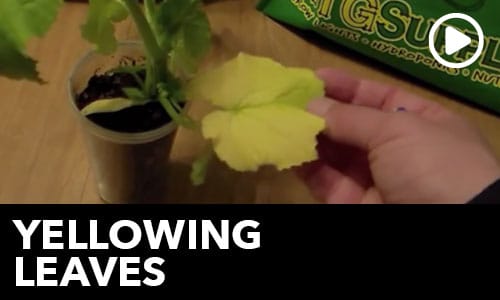Vertical horticulture has been a staple of crop cultivation for thousands of years. Ancient Greeks and Romans tended fields of grapevines grown vertically on wooden posts, and the mythical hanging gardens of Babylon serve as one of history’s forever lost treasures. The first “modern” vertical garden was installed in 1986 at the Museum of Science and Industry in Paris, the brainchild of French botanist Patrick Blanc.

Copyright Pascal Heni
This green wall kick started the vertical revolution, with firms and cities across the globe seeking to replicate the new greenery in otherwise steel and gray urban landscapes. From DIY tiered gardens you can build in your own backyard to massive walls of lush flora that decorate city buildings, vertical gardens come in a range of shapes and sizes.
When we talk about vertical gardens, the key distinction to draw is between a vertical produce farm/garden and a vertical decorative/aesthetic garden. Vertical production gardens can range from a DIY pallet garden to commercial vertical farms, which utilized tiered growing systems to produce herbs, leafy greens, and other high-yield crops. Aesthetic vertical gardens are primarily what you’ll see in urban spaces, sections of greenery covering city building sides.
Through this Talking Shop, we’ll first talk about aesthetic vertical gardens, then move to vertical farms. You will learn why cities toss green walls up in the first place (it’s a lot more than just for looks) and how commercial vertical farms are pushing the bounds of what cultivation looks like today and their vital impact into the future.
GREEN WALL
Green walls have enjoyed a steady rise in popularity since the mid-1980’s, and it’s no surprise why. Notable installations are in cities. Lush, green plants interrupting the overtly drab urban landscape is a beautiful, a welcome relief to city-goers. Green walls come in all shapes and sizes, and their construction varies, dependent on the climate and the city in which they reside. Indoor walls are afforded the most diversity in planting (their climate is controlled by HVAC systems) while outdoor walls will usually reflect the local climate zone. A pretty sight isn’t the only benefit to green walls, as we’ll see there are plenty of reasons beyond just a love of grass and flowers that drive the decisions behind green wall construction.
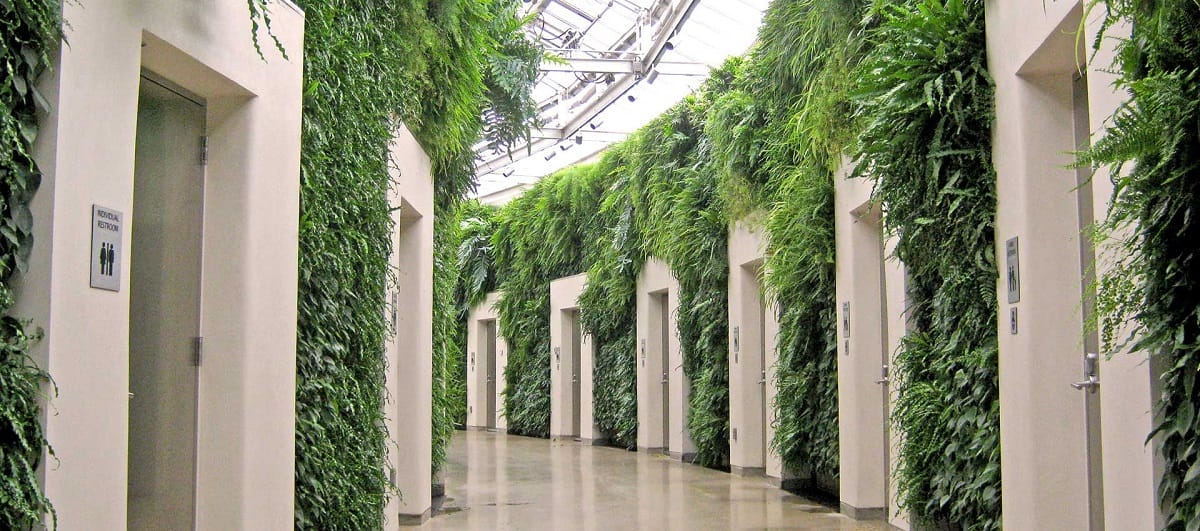
A green wall is a structure, usually attached to a wall or building, that has planting sites with media or substrate extending up through the structure. In general, green walls are constructed with a waterproofing layer on the backside (to prevent damage to the structure they’re decorating). On the front face, there are a variety of planting methods. This can take many forms such as:
Loose Media
Loose medium walls, ones that use soil troughs or containers such as grow bags, are most common in residential applications. These gardens are maintained through the yearly or bi-yearly replacement of soil and plants, making soil-based green walls the most labor intensive. On the bright side, the use of soil opens up a wide array of possibilities for species to plant in the wall. Soil allows for a larger and more vibrant root system from a single plant, so there is the possibility to grow vegetables out of a loose medium green wall. Loose media walls are the easiest to DIY as well, as all you need to do is mount a few planters vertically and shebang you have your own loose media wall.
Mat Media
Mat media green walls get their namesake from their build, these systems are created using mats of growing media such as felt or coco coir. Much like any hydroponic system using coco, the inert medium gives plant roots an effective substrate to thrive. These walls are maintained by the periodic replacement of sections of the mat media. After a few years, roots will tend to clog up the mat to a point where water cannot wick through the material and sections of the mat will be cut, removed, and replaced with new matting. Smaller plants, such as grasses and small flowers, work best for these.
Sheet Media
Sheet Media green walls use textured polyurethane cells to hold plants, the same material our grow bags are made out of! Polyurethane walls last the longest, as the plastic planting sides are inorganic, they don’t biodegrade. Two sheets of the poly, usually with an irrigation system between them, are used to hold plants in small pockets created by their egg-carton texture. Much like the mat media walls, sheet media is better suited to hold small plants and grasses.
Structural Media
Structural Media Green walls make use of Rockwool (or similar) cubes to support plant growth. Rockwool lasts anywhere from 10-20 years, dependent on the plants its holding and the maintenance it receives. In the same way that loose media walls use troughs or bags of soil, structural media wall use Rockwool sites to grow plants, making replacement a breeze and upkeep simple. This style wall has the capacity to hold larger plants, because the plants are rooted in substrate and not just a mat.
WHY/FUNCTIONS
Green walls provide tangible benefits to the building and the urban area in which they are planted. Buildings and the immediate outdoor area are kept cooler, water is cleaned, and common pollutants are pulled out of the air.


Reduced Cooling Costs
Cities are often referred to as “heat islands” in climatology, because of the vast stretch of concrete, asphalt, and buildings that soak up the heat from the sun. Much like a scorching hot blacktop on a sweltering day, almost every surface in a city traps heat. The technical term for this is insulation, the absorption, storage, and release of solar heat radiation by structures and roads in urban environments. In these environments asphalt can reach temperatures over 60F higher than the air temperature, famously enough to cook an egg, and brick and metal surfaces will rise to scorching hot temperatures as well. Much like people sweat to keep themselves cool, plants also have the ability to transpire, and their surface temperatures only rise to a maximum of about 10F beyond ambient temperatures. Plants keep themselves cool, and in turn block solar rays from reaching the exterior of buildings. This has two purposes, the cooling cost of the green wall building is reduced as its exterior is no longer heated by the sun, and the immediate area around the green wall will be slightly cooler. Cooling building walls results in lower cooling costs inside, and the perspiration from the green wall counteracts some of the insulation of city concrete.
Water Purification
For any green wall that is irrigated in part with rainwater, the plants and root zones function as a bio filter for the water. Water in and around cities generally is not the cleanest, especially if it’s coming from ponds, rain barrel, or sewer systems. Beneficial bacteria and fungi in a green wall’s substrate absorb, process, and break down common pollutants in gray water and urban rainwater. The ultimate benefit of this is the reduction of pollutants expelled by municipal drainage systems, leading to better water quality both in the city and near the outlet of the city’s drainage system.
Air Purification
Due in part to the way cities streets are configured urban street canyons, gulches formed by stretches tall buildings, tend to trap pollutants and vehicle emissions. Winds that would otherwise take up emissions are blocked by buildings, creating a microenvironment of increased levels of NO2 (nitrogen dioxide) and particulate matter. If you’ve ever walked down a city street at the peak of rush hour, you can just smell and taste the exhaust in the air. Studies have shown that green walls in street canyons can reduce NO2 by up to 40% and particulate matter up to 60%1, drastically cutting back the pollution that is all too common to urban living. This provides cleaner air for city residents and smooth’s spikes in pollution that occur during traffic congestion.
FACADES
As we said earlier, it’s important to draw a distinction between green walls and green facades. As opposed to containers or substrates running vertically up the wall, green facades are created with a single trough or container near or at the ground level. Vining plants are cultivated at the base and trained up the structure. Think of any old fence covered in greenery, that’s a natural green facade. It’s likely that the climbing plant simply found its way through the pickets and links. While green walls are primarily constituted of decorative flowers and grasses, green facades require climbing plants.
Green facades are the most common type of vertical gardens. The reason behind the “façade” moniker is green facades only have plants rooted in the ground and grown up into trellis netting, vining up a wall, or mingling into a fence. Instead of a “true” green wall, just a few plants are used to create the impression of one. If you look around your neighborhood, you’re more than likely to see a fence or walls covered in vines or flowers, very essential, very basic vertical gardens.
Green facades differ in construction from green walls. The lack of planting sites on the wall greatly reduces both the cost and construction. Starting at the base of the facade wall, either planters are built into the ground or raised beds are fabricated, both working to hold the soil base. The vines are then planted at the base of the wall and trained up into a trellis structure. As opposed to the oftentimes complex green wall construction, green facades simply need any type of wire trellis grid or other, similar support structures to give climbing plants sites to grip. Once the vines reach the trellis, soon it’ll be green all the way up.
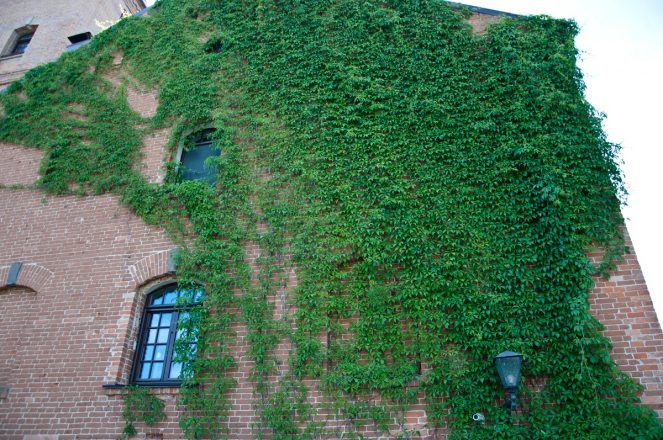
General Plant Varieties for Green Facades
Twines
Twining plants, such as Morning Glories, common ivy, honeysuckles, and Clematis buttercups climb using their stems or petioles (the slim stalk between the leaf and the stem). These plants will twist around any support structure, such as trellis netting, fencing, poles, and really anything you choose to direct their growth vertically.
Adhesive Pads
Some climbing plants, like the Virginia creeper, use adhesive pads on their tendrils to secure themselves as they ascend. Disc-shaped pads grow at the tips of these plants’ tendrils and are coated with a natural adhesive. The plant then find and sticks itself to a wall. Unlike other climbing plants, adhesive pad varieties do not need any type of support structure to climb, just a relatively smooth surface to attach their adhesive pads to.
Clinging Stem Roots
Plants with aerial rooting, like climbing hydrangeas or English Ivy, find their way to the sky using tiny, root-like extensions that grow out of their stems. These roots are used attach themselves to a surface. Much like plants with adhesive pads, clinging roots just need a surface to climb, not any type of support structure. Clinging roots require rougher surfaces to grip, but once they’re latched on most species demonstrate incredible hold.
VERTICAL FARMING
Now let’s turn our attention to the meat and potatoes, or better said kale and tomatoes, of the future of vertical gardening. The advent of affordable, efficient LED horticultural lighting has enabled vertical farms to not only grow effectively, but also compete against the prices of traditional agriculture. Vertical Farming, very basically, makes use of vertical space to cultivate food crops.
In general, vertical farms will either be completely enclosed in structures like warehouses, towers, or shipping containers, or they’ll be greenhouse based tiered growing structures. This is the key divider between vertical farms, are they an original building that ingrates natural light or an enclosed area, sometimes in abandoned or empty buildings. When we open up the doors and look inside (or just look through the windows), we’ll see generally the same production methods. In order to maximize crop production, most vertical farms utilize NFT-style hydroponic systems to grow their crops, but depending on the farm’s size, location, and crop, ebb & flow and drip systems may be used instead. Beyond these general similarities, there is a massive diversity in how facilities manage their plants. Some farms will use mechanical racks to rotate crops under lights and next to greenhouse windows, while others simply stack rows of trays under rows of LED grow lights. Regardless of their specific technique, all the cultivation methods used in vertical farms seek a balance between maximizing plant material per square foot of floor space, producing high-quality produce, and minimizing power consumption.
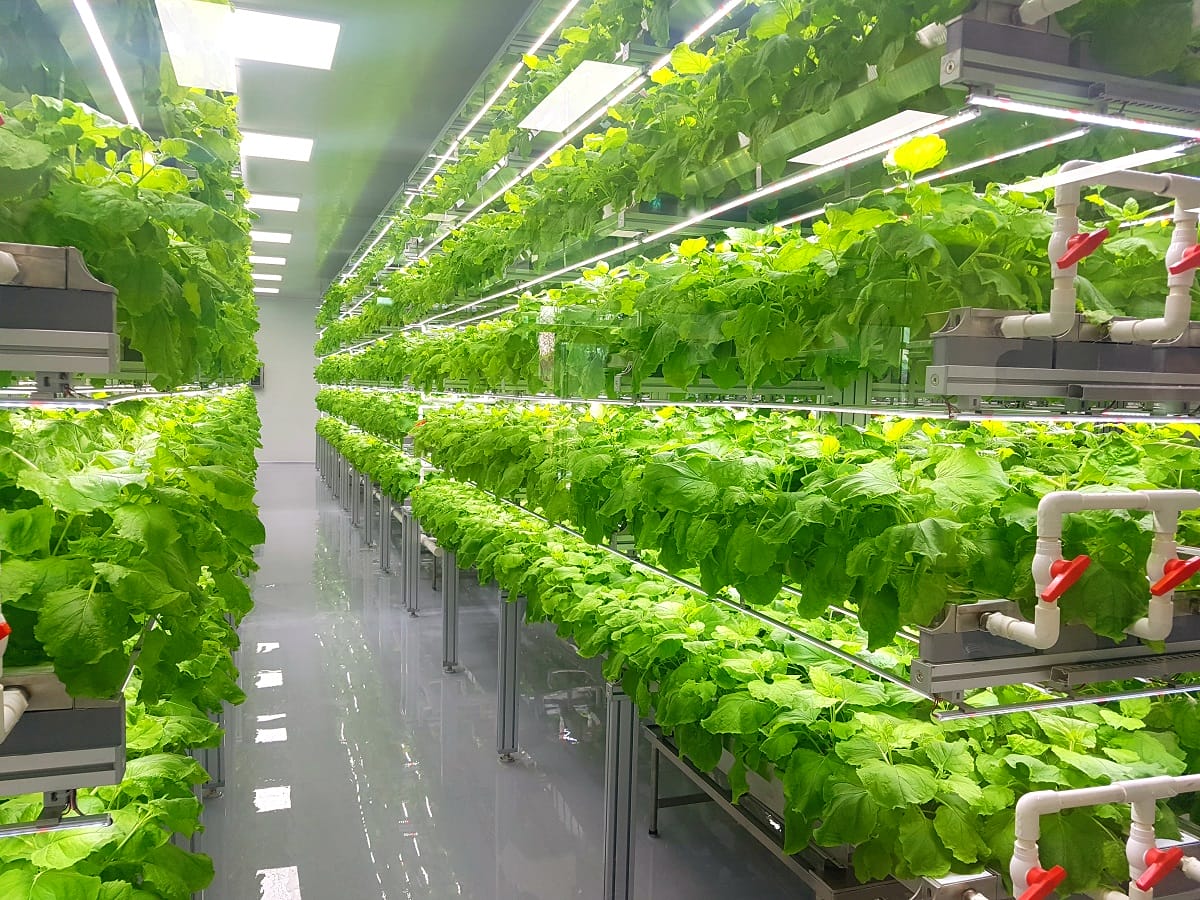
Crops grown in vertical farms tend to be fast-growing varieties of leafy greens, like kale, lettuce, arugula, spinach, micro greens, and so on. The reason for the dominance of these crops is twofold, they can supply a constant output of fresh produce, and they’re relatively easy crops to grow with lighter water and nutrient requirements than say tomatoes or zucchini. In recent years, vertical farms have been experimenting with producing virtually every supermarket crop.
The Benefits of Vertical Farms
Crop Production Efficiencies
Vertical farm hydroponic systems, in general, are about 20x more efficient in water usage than traditional farming techniques. This reduces the amount of total water used and water wasted in vertical farms. Production per square foot is maximized, anywhere from 4-30 fold depending on the crop. Year-round production becomes possible in non-tropical regions, giving vertical farms the advantage while the surrounding crop fields are covered in snow. Additionally, much like greenhouse production, light cycles indoors can move beyond daylight hours. Exposing plants to more light in a 24 hour period can further accelerate their growth.
Environmental Benefits
Vertical farms will reduce the need for traditional field-based farming, and when vertical farms can prove to be more cost effective, reduce the total land used for crop production and reduce the negative externalities of farming. About 38% of total land in the world is farmland4, much of which could be reclaimed by nature (or used for other purposes). Vertical farms may lead to the restoration of farmland, as well as the repopulation of species impacted by farming activities. Deforestation, driven by a need for agricultural land, would be drastically reduced. Fertilizer and pesticides will no longer pollute environments adjacent to farms, and the lighter requirements for water and irrigation should help to combat droughts. Vertical farming moves production out of the fields and into specialized structures, giving the Earth just a little bit more room to breathe.
Social Benefits
Vertical farms produce healthier, more flavorful food and provide food security to urban populations. Since the post WWII population boom, commercial agriculture has sacrificed the flavor and nutritional value of fruits and vegetables in favor of longer shelf life. Produce variety has dropped sharply too, there are over 400 varieties of tomatoes with a wide spectrum of appearance and flavor, but you wouldn’t know that with the 3 or 4 bland slow-ripening types sold in supermarkets. Garden favorites like tomatoes and bell peppers are picked unripe and allowed to ripen in transit from field to distribution to the grocer’s shelf. This early picking and longer storage interrupts the natural ripening process of the plants, reducing vitamin C by 30% in tomatoes and bell peppers, stifling antioxidant production, and cutting short the full flavonoid development of the crop3. Vertical farms do not suffer from these issues because there’s no need to ship produce thousands of miles to market. Production in vertical farms enables produce to fully ripen on the plant before being picked and sold in local markets, giving consumers better nutritional value and more flavorful food. This locality benefit has a second purpose, expanding urban populations do not need to rely on food being imported cross-country. Instead, urban areas can begin to grow their own crops and maybe someday in the future, cities will be entirely self-sufficient in their produce consumption.
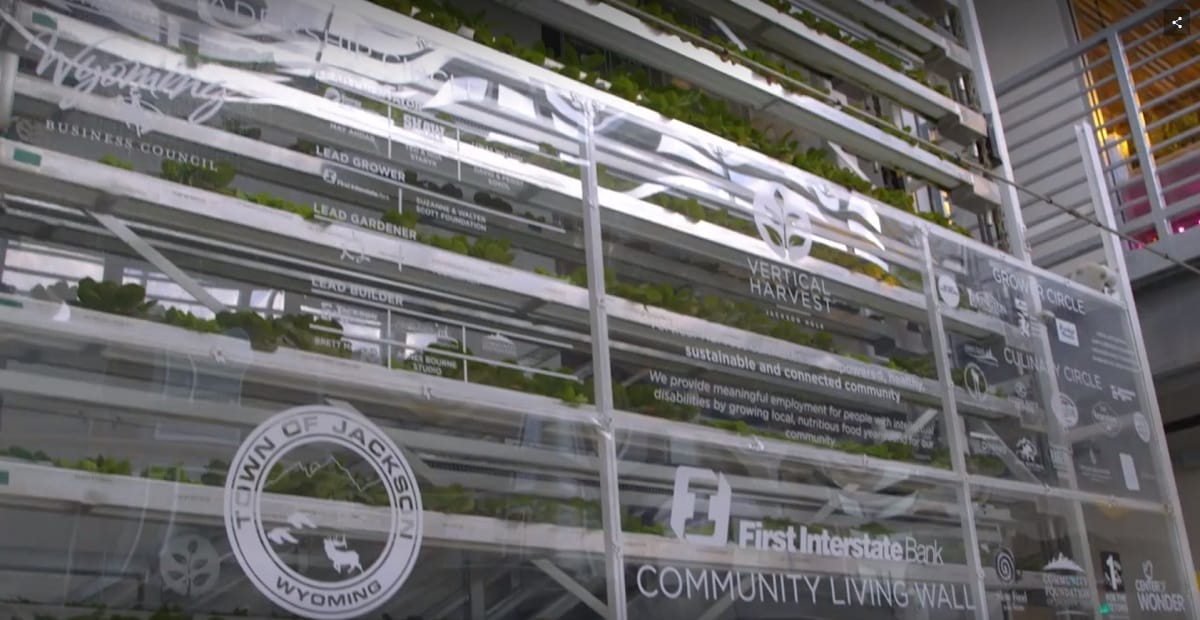
Current Issues
Energy Cost and Consumption
Unlike outdoor fields that get 100% of their light from the Sun (free of charge), vertical farms generally must supplement their crops with artificial light, especially if there is no greenhouse structure to let in natural light. In addition, climate control elements such as HVAC and dehumidifiers, pumps and plumbing for water and runoff, and the mechanical operation of the farms all contribute to the cost of production. Energy consumption issues can be amplified, dependent on the electricity generation methods. For vertical farms located in areas that burn fossil fuels for energy production, the power that is used to grow crops also pollutes the air and water of the region.
Crop Prices
Traditional agriculture has relatively few input costs compared to vertical farms, and that is one of the key factors limiting the expansion of vertical farms right now. It’s just simply cheaper to grow crops in fields and ship them halfway across the country than it is to grow them indoors. Additionally, the startup cost for an acre of farmland is drastically smaller than the same sized vertical farm. Initial capital requirements are in the tens of millions for commercial vertical farms, compared to a couple thousand for unutilized land. Labor costs also drive up the prices of vertical garden crops, as vertical farms require about 20 times more workers than greenhouses to manage their plants and hydroponic systems. Putting it all together, it’s expensive to build, expensive to operate, and expensive to maintain crops in a vertical farm; all expenses which eventually show in the final price of their produce. This is not to say that there aren’t profitable vertical farms, there are, but rather that costs are severely limiting the expansion of vertical farming.
Growing up isn’t a new concept, but it has been gaining steam in the past few decades with innovations in controlled environment agriculture and increasing interest in community and urban agriculture. With everything from vining green facades covering unsightly exposed brick to shipping containers retrofitted with LED lights and tiered planting systems, vertical gardening captures the future of urban and production gardening in the 21st century.
FEATURED COUPON CODE: VERTICAL10
Enter our featured promo code at checkout for a 10% discount on qualifying indoor gardening tools & accessories*. Thanks again for tuning into Talking Shop with HTG Supply! Offer valid through HTGSupply.com and in-store. Cannot be combined with other offers. Follow us on social media for all the Sales, Events and Customer Appreciation Days. In addition, learn more about indoor growing and get all kinds of tips, tricks and techniques!
*Excludes trimmers and extraction systems


